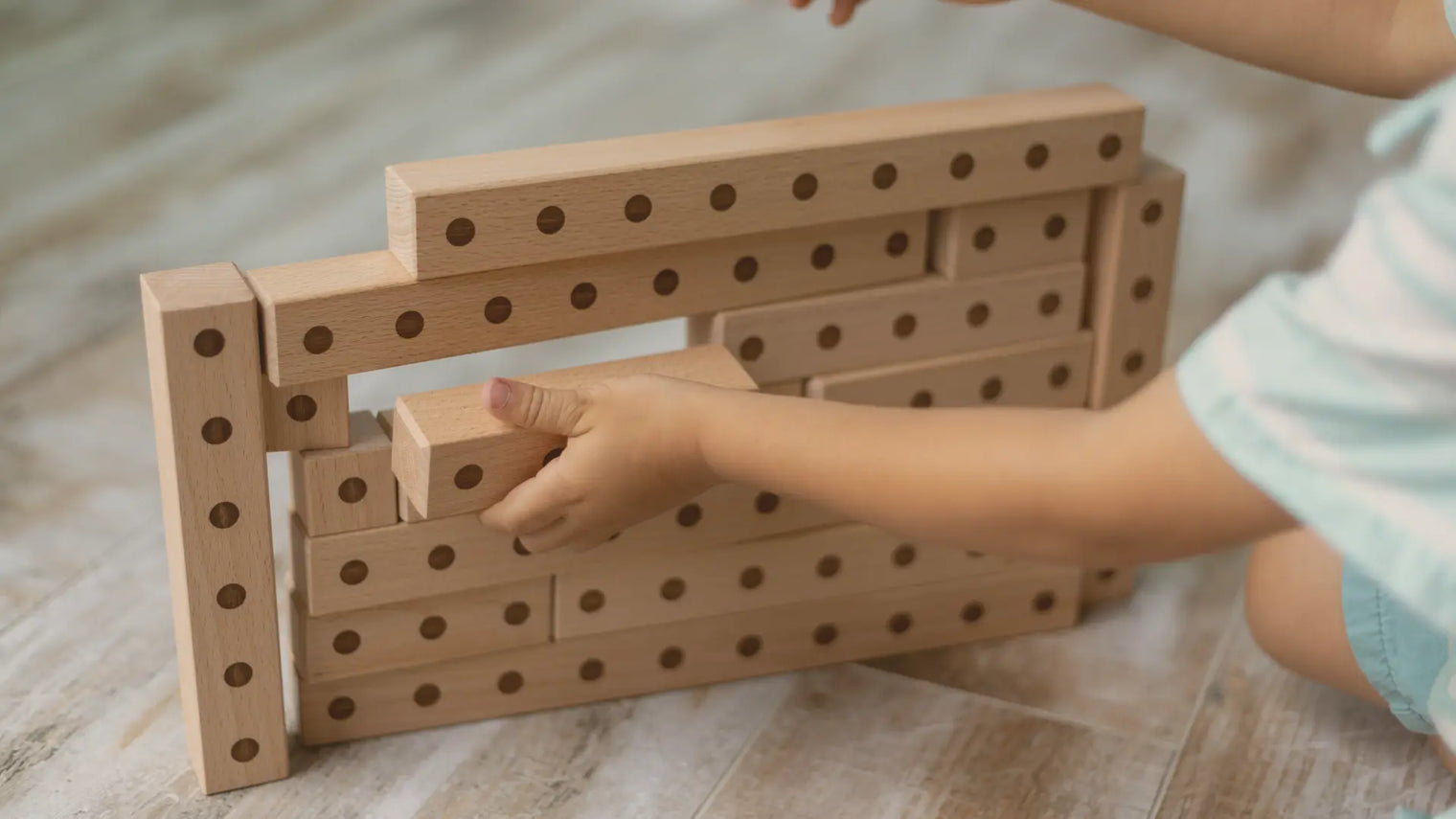Discover the research-backed reasons why Montessori number blocks are so effective for early math learning. Science meets education in concrete learning.
At Dannico Woodworks, we’re passionate about designing furniture and tools that spark curiosity, creativity, and independence in children.
One of the most effective tools we’ve seen in early math education is the Montessori Number Blocks.
If you’ve ever wondered why these simple wooden blocks seem to capture a child’s attention and make numbers “click,” this post is for you.
Understanding why Montessori Number Blocks work—and how they can help your child develop strong foundational math skills—is more important now than ever.
The Montessori Approach to Learning
Before diving into the blocks themselves, it’s helpful to understand the Montessori philosophy.
Maria Montessori, the Italian physician and educator, believed children learn best when they are actively engaged with hands-on materials that encourage exploration and independence.
Her methods focus on allowing children to discover concepts at their own pace, rather than relying solely on worksheets or lectures.
Montessori learning tools are designed to be tactile, visually clear, and logically structured.
They make abstract concepts concrete. For numbers, this means children can see, touch, and manipulate quantities in a way that makes sense to them—long before they start memorizing multiplication tables or doing complex arithmetic.
This is where Montessori Number Blocks shine.
What are Montessori Number Blocks?
Montessori Number Blocks are wooden blocks that represent numerical values in a tangible form.
Each block corresponds to a specific number, often with visual or tactile cues that reflect the number’s quantity.
For example:
-
A block representing the number 1 might be a single unit block.
-
A block for 2 could be two units stacked together.
-
Larger numbers might be represented with rods, cubes, or stacked blocks.
These blocks are usually colorful and designed in a way that children can easily distinguish between quantities.
Unlike traditional flashcards or digital apps, Montessori Number Blocks encourage children to physically manipulate numbers, creating a multisensory learning experience that reinforces understanding.
Why Montessori Number Blocks Work So Well
1. They Make Abstract Numbers Concrete
Numbers can be an abstract concept for young minds. Children often struggle to understand that “5” isn’t just a symbol—it represents a set of five objects.
Montessori Number Blocks transform numbers into something tangible. Children can touch, stack, and move the blocks, which helps them internalize the idea of quantity.
2. They Encourage Hands-On Learning
Research consistently shows that children learn more effectively when they can engage multiple senses.
Montessori Number Blocks offer a hands-on experience that reinforces learning through touch, sight, and movement.
By physically manipulating the blocks, children develop a stronger, more intuitive sense of numbers.
3. They Build Visual and Spatial Awareness
Working with blocks requires children to think spatially. They learn to arrange numbers in sequence, compare sizes, and notice patterns.
This spatial reasoning isn’t just helpful for math—it also supports skills in science, engineering, and everyday problem-solving.
4. They Promote Independent Learning
Montessori materials are intentionally self-correcting.
Many Number Blocks are designed so children can see immediately if they’ve made a mistake—such as stacking the wrong number of units.
This promotes independence and confidence, because children don’t have to rely on an adult to constantly check their work.
They learn to notice errors, correct them, and understand the logic behind numbers on their own.
5. They Foster a Love for Math Early On
Math anxiety is a real problem, and it often starts in early childhood when numbers are presented in a confusing or intimidating way.
Montessori Number Blocks remove that anxiety by making learning playful and interactive.
Children begin to associate numbers with fun, problem-solving, and hands-on activity—not stress. This positive early experience can have lasting benefits.
How to Introduce Montessori Number Blocks to Your Child
Introducing Montessori Number Blocks doesn’t require a full classroom setup. You can start small at home with a few principles in mind:
-
Start Simple: Begin with numbers 1–5 before moving on to higher numbers.
-
Encourage Exploration: Let your child stack, arrange, and count the blocks freely.
-
Ask Open Questions: Instead of giving answers, ask, “How many blocks are here?” or “What happens if we add one more?”
-
Use Daily Life Examples: Reinforce learning by connecting blocks to objects at home, like toys, fruits, or utensils.
-
Create a Routine: Even 10–15 minutes a day can make a difference. Consistency helps children internalize concepts naturally.
At Dannico Woodworks, we’ve designed Number Blocks and complementary furniture pieces that integrate seamlessly into your child’s space.
Our sturdy wooden blocks and well-crafted shelves encourage children to access materials independently, promoting both learning and self-sufficiency.
Benefits Beyond Math
While the primary goal of Montessori Number Blocks is to teach numerical concepts, the benefits extend far beyond counting. Children also develop:
-
Fine Motor Skills: Manipulating blocks strengthens hand-eye coordination.
-
Problem-Solving Skills: Arranging blocks in sequences or creating patterns develops critical thinking.
-
Patience and Focus: Engaging with blocks requires concentration and perseverance.
-
Confidence: Successfully solving a problem or stacking blocks correctly gives children a sense of accomplishment.
These skills transfer into other areas of learning and everyday life, giving children a well-rounded foundation that supports overall development.
FAQs
At what age should children start using Montessori Number Blocks?
Children as young as 2–3 years old can begin exploring number blocks, starting with very small quantities. Older preschoolers can work with higher numbers and more complex arrangements.
Can Montessori Number Blocks replace traditional math teaching?
Number Blocks are a supplement, not a replacement. They are most effective when used alongside other learning activities that promote numeracy, such as storytelling, puzzles, and real-life counting exercises.
How can I make learning with blocks more engaging?
Incorporate games, challenges, or collaborative activities. For example, ask your child to build a tower with exactly 10 blocks or match blocks to groups of objects around the house.
Do Montessori Number Blocks work for all learning styles?
Yes! They’re particularly effective for visual and kinesthetic learners but also benefit auditory learners when counting aloud.
The tactile, visual, and manipulative elements make learning accessible to nearly every child.
Creating a Learning-Friendly Environment at Home
To maximize the effectiveness of Montessori Number Blocks, consider creating a dedicated space for exploration.
This could be a low shelf where blocks are easily accessible, a small table for arranging and counting, or even a corner of a room where your child can freely engage with materials.
At Dannico Woodworks, we craft furniture specifically with these principles in mind—low shelves, accessible storage, and durable surfaces that invite children to explore independently.
By giving your child a safe, organized, and inviting space, you make it easier for them to engage in meaningful learning through play.
Conclusion
Montessori Number Blocks work because they transform abstract concepts into tangible, engaging experiences.
They foster independence, encourage hands-on exploration, and develop both cognitive and motor skills—all while making math fun.
When children interact with these blocks, they’re not just learning numbers—they’re developing a mindset for problem-solving, creativity, and lifelong learning.
If you’re looking for ways to enrich your child’s learning environment while nurturing independence and curiosity, Montessori Number Blocks are a practical, effective tool.
And when paired with thoughtfully designed furniture that supports accessibility and engagement, the possibilities are endless.
At Dannico Woodworks, we’re proud to create furniture and materials that make this kind of learning both possible and enjoyable.
Imagine a space where your child can explore, play, and learn independently—how would that change the way they see numbers and the world around them?

